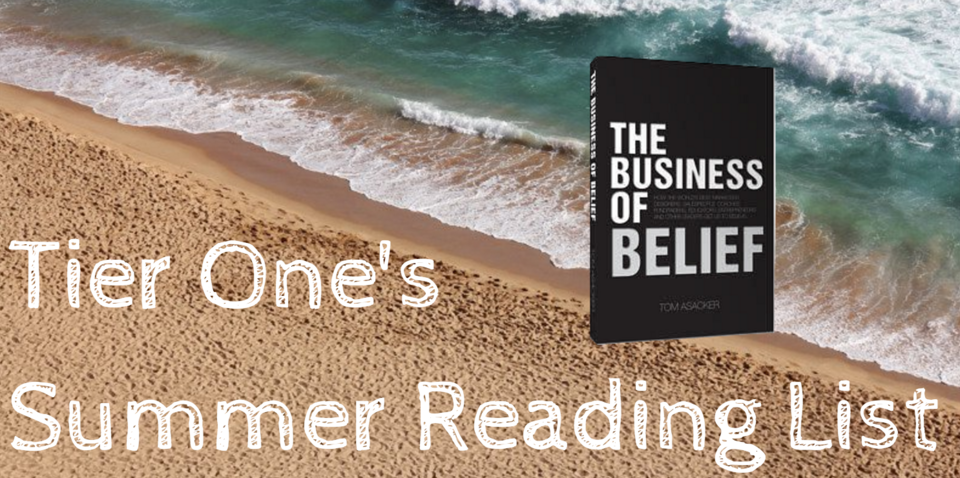Making True Believers: An Overview of The Business of Belief

Posted By Kathy Wilson on June 22, 2016
Belief is a powerful emotion and it’s one we all work to cultivate on a daily basis – whether we’re aware of it or not. All of us need to make believers of our key “audiences”: whether those are our customers, employees, board members, business partners, local town hall participants, students, or even our own family members.
Belief is even more important in today’s world, where our choices are greater than ever before and made even further confusing by an increasingly high “noise level” in the market.
I recently had the opportunity to read Tom Asacker’s book, The Business of Belief: How the World’s Best Marketers, Designers, Salespeople, Coaches, Fundraisers, Educators, Entrepreneurs and Other Leaders Get Us to Believe.
Asacker’s premise is that capturing people’s attention is no longer good enough. Instead, we need to make people believe to accomplish anything in our business or personal lives.
Fair enough. So, where do we start?
Why Do We Believe?
Asacker postulates that we choose what we choose because we believe in it – essentially, own our personal prejudices (my word). And those beliefs are driven by our desires. It’s an emotional construct. And to understand how and why we believe offers us the opportunity to motivate ourselves, make better decisions and create conditions so others will motivate themselves to choose us.
Asacker guides us through a number of short stories – ranging from Sir Arthur Conan Doyle to John F. Kennedy to the ‘60s musical star Sixto Rodriquez – to illustrate his point that perception is reality for most of us. In other words, it’s our intuitive, “feeling” mind that directs our analytical, “thinking” mind. As Asacker says, “Our gut, rather than our head, steers our attention and behavior.”
Our intuitive minds serve as a powerful guide in directing our attention and informing our beliefs. And when this mind is proven to be right, the value of those beliefs is reinforced. According to Asacker, “Our perception becomes our reality, and a belief is born.”
The reason everyone’s beliefs are different, however, and what makes forging belief often challenging is because what we see depends on what we believe – how our individual minds are wired with information and personal experiences. Americans are living this right now through this political season and the varied interpretations we all make to the candidates statements and positions. “We only see what we’re prepared to see,” says Asacker, “and what we expect to experience influences what we do experience.”
Enter Storytelling and Desire
Asacker spotlights the power of storytelling as a way of making sense with the world. Storytelling makes it easier in a busy environment for our minds to see patterns and make the personal associations on which beliefs are based.
The individual choices we each make are driven by desires and our need to edit and control our own stories. Says Asacker, “Our desires are constantly being stimulated and reinforced by outside forces and life circumstances…Desire is the spark that ignites your beliefs and fuels your actions…Desire is what moves you from thinking to doing.” This is what we at Tier One call making “emotional connections,” which we believe is a critical component of marketing success.
Can Beliefs Be Changed?
The second part of Asacker’s book focuses on the art of changing someone’s deeply rooted beliefs.
Effective marketers understand how to get consumers to cross “new bridges” of belief by making new ideas and concepts appear familiar and easy to interpret and accept. Asacker argues that the imagery used to get someone on a path to a new belief can’t be scary or uncomfortable, but spurred by a positive association and benefit. The best leaders, marketers and salespeople know that engaging consumers and soliciting opinion about the things that matter to the “buyer” are the keys to success. Asacker says, “Making it ours is not giving us control of the ship. Rather, it’s connecting the voyage – especially the questions, highlights and successes – to our desires and choices. Great leaders of all stripes make it ours by making us feel that we are at the center of things.”
To change a belief, it must be easy. “Distractions and difficulties turn on our thinking mind, which undermines belief by overriding our instincts,” says Asacker.
Changing beliefs must also be reinforced, whether it’s a marketer that strategically rewards our loyalty (as Tier One’s client Stellar Loyalty helps brands do) or other mechanisms that continually remind us that we’ve chosen the best course. Changing beliefs requires passion on the part of the person or organization trying to affect that change, as well as knowledge of when to push and when to hold back (impulse control) so we’re not overpowering the person on their journey to new beliefs.
The Art of Making Conscious Choices
The final part of Asacker’s book focuses on the ability we each have to slow down and be more conscious of our choices. He describes the effect of today’s “Google-anything-and-have-10,000-results-instantly” culture in discouraging risk taking since it’s too easy to point to data or other ideas already in the market as reasons why our ideas won’t work. Asacker encourages readers to follow their curiosity and passion as they create new beliefs.
“Today, more than ever before,” Asacker writes, “we’re hooked on the visible – short-term stimulation that’s injected directly into our brains. If you want to change your life, you must reverse the order of that default-setting. Instead of being driven by your senses, be driven by a belief – in something bigger and better.”
The Business of Belief is a quick read (yes, even a summer beach read) that will leave you feeling empowered and ready to rethink your approach to business and life as we go about our daily task of creating true believers.

Kathy Wilson
Kathy Wilson is a Co-founder and Managing Partner at Tier One, where she leads the agency's Boston office and serves as a strategic client counselor. She taps her three decades of experience in B2B and B2C technology, digital healthcare, and financial services — including work counseling major brands like SAP, Citrix, Ultimate Software, GHX, and Ally Financial — to help clients meet critical business and marketing objectives. Kathy is a die-hard Red Sox fan and loves nothing better than a summer day at Fenway Park.


